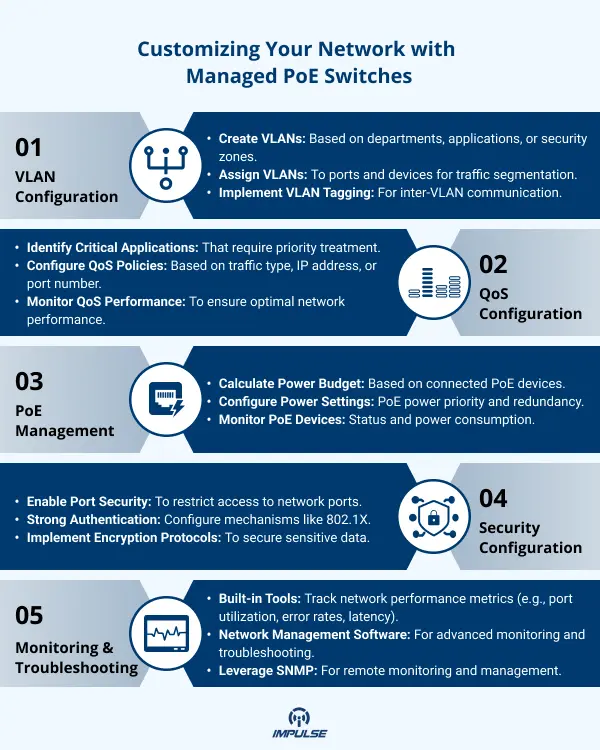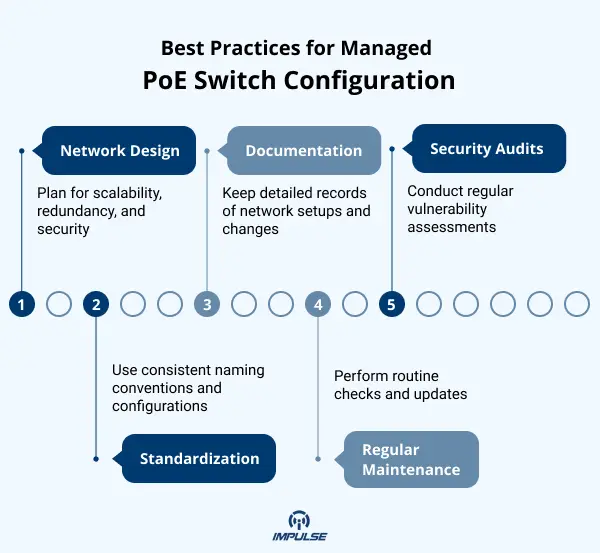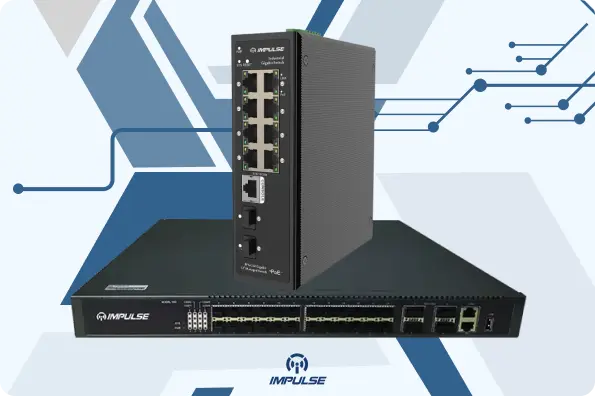In the dynamic landscape of modern networking, the demand for efficient and reliable network infrastructure is paramount. Managed PoE (Power over Ethernet) switches have emerged as a cornerstone for businesses seeking to optimize their network performance. By offering granular control over network traffic, these switches empower network administrators to tailor their network to specific needs and applications. This blog delves into the intricacies of managed PoE switches, exploring their capabilities, configuration best practices, and the transformative impact they can have on your network.
Understanding Managed PoE Switches
Managed PoE switches are the intelligent brains behind efficient network operations, playing a crucial role in modern network infrastructures. Unlike their unmanaged counterparts, these advanced switches offer a plethora of features that empower network administrators to fine-tune network performance meticulously, ensuring seamless and optimized operations. The ability to prioritize critical applications and fine-tune network settings makes them indispensable in complex network environments. Key functionalities of Power over Ethernet (PoE) technology include:
- VLANs (Virtual Local Area Networks): These allow the creation of isolated network segments, which not only enhance security by isolating sensitive data but also optimize traffic flow within the network. This segmentation helps streamline network management by reducing broadcast domains and simplifying troubleshooting processes.
- QoS (Quality of Service): This feature is essential for prioritizing critical applications such as voice, video, and data traffic. By ensuring that these applications receive the necessary bandwidth, QoS prevents network congestion and guarantees smooth performance, which is critical for maintaining the quality of services in business environments.
- IGMP Snooping: This functionality is crucial for optimizing multicast traffic distribution. By monitoring IGMP (Internet Group Management Protocol) communication, the switch can efficiently manage video streaming and other multicast applications, ensuring that multicast traffic is delivered only to the devices that need it, thus conserving bandwidth and improving overall network efficiency.
- PoE Management: Managed PoE switches provide sophisticated control over power delivery to PoE-enabled devices. This includes the ability to prevent power overloading, monitor power consumption in real-time, and ensure that power is allocated efficiently across all connected devices. This level of control is vital for maintaining the reliability and stability of the network, especially in environments where numerous PoE devices are deployed.

Customizing Your Network with Managed PoE Switches
To fully leverage the capabilities of managed PoE (Power over Ethernet) switches, it’s essential to understand how to configure them effectively. This involves not only grasping the basic setup processes but also becoming familiar with advanced features such as VLAN configuration, QoS settings, and security protocols. Additionally, regular updates and maintenance, as well as monitoring network performance, are crucial to ensure that the switches provide optimal functionality and support for your network infrastructure.

VLAN Configuration:
- Create VLANs based on various criteria such as departments, applications, or security zones. This helps in organizing and managing network traffic more effectively.
- Assign VLANs to specific ports and devices to ensure traffic segmentation, which isolates different types of traffic and enhances security.
- Implement VLAN tagging to facilitate inter-VLAN communication. This allows different VLANs to communicate with each other while maintaining their segmentation and security.
QoS Configuration:
- Identify critical applications that require priority treatment. This includes applications such as VoIP, video conferencing, and other real-time services that are sensitive to latency and jitter.
- Configure QoS (Quality of Service) policies based on traffic type, IP address, or port number to prioritize important traffic. This ensures that critical applications receive the necessary bandwidth and performance.
- Monitor QoS performance regularly to ensure optimal network performance. Adjust QoS settings as needed to accommodate changing network conditions and application requirements.
Also Read: POE vs. Non-POE Switches: What’s the Difference?
PoE Management:
- Calculate the power budget carefully based on the number and type of connected PoE (Power over Ethernet) devices to ensure sufficient power distribution.
- Configure PoE power priority settings to determine which devices receive power in case of limited availability and set redundancy options to maintain power supply during failures.
- Continuously monitor the status of PoE devices and their power consumption to prevent overloads and ensure efficient power usage.
Security Configuration:
- Enable port security features to restrict which devices can access network ports, thereby preventing unauthorized devices from connecting.
- Configure strong authentication mechanisms such as 802.1X to ensure only authorized users and devices can access the network, providing an additional layer of security.
- Implement robust encryption protocols to protect sensitive data transmitted over the network, ensuring that it remains confidential and secure from potential eavesdroppers.
Monitoring and Troubleshooting
- Utilize the built-in monitoring tools available within your network equipment to track various network performance metrics, such as port utilization, error rates, and latency, allowing for the identification of potential issues.
- Implement advanced network management software that provides comprehensive monitoring and troubleshooting capabilities, enabling proactive management of network health.
- Leverage SNMP (Simple Network Management Protocol) to facilitate remote monitoring and management of network devices, allowing for efficient oversight and maintenance.
- Document the entire network topology and configuration details meticulously, which aids in efficient troubleshooting and quick resolution of network issues when they arise.
Best Practices for Managed PoE Switch Configuration
- Network Design: Create a well-structured network design considering scalability, redundancy, and security requirements. This may include planning for future expansions, identifying critical points of failure, and ensuring that the network can handle increased traffic loads without compromising performance.
- Standardization: Implement consistent naming conventions and configuration standards for easier management. Standardization helps in reducing errors, making troubleshooting more efficient, and ensuring that all team members are on the same page when it comes to network configurations.
Best Practices for Managed PoE Switch Configuration

- Documentation: Maintain detailed documentation of network configuration and changes. Documentation should include network diagrams, configuration files, change logs, and any other relevant information. This helps in managing the network effectively and provides a reference for future upgrades or troubleshooting.
- Regular Maintenance: Perform routine checks and updates to ensure optimal performance. Regular maintenance tasks might include updating firmware, monitoring traffic patterns, checking for hardware issues, and ensuring that all devices are operating within their specified parameters.
- Security Audits: Conduct regular security assessments to identify and address vulnerabilities. Security audits should involve both automated tools and manual reviews to ensure that all potential threats are identified and mitigated. This could include checking for outdated software, ensuring that access controls are properly configured, and monitoring for unusual activity that might indicate a security breach.
Conclusion
Managed PoE (Power over Ethernet) switches are indispensable tools for building robust and efficient network infrastructures. These devices not only supply power and data connectivity to various network devices through a single Ethernet cable but also provide advanced management features that enable administrators to monitor and control network traffic more effectively. By understanding and effectively utilizing their capabilities, organizations can optimize network performance, enhance security, and support the demands of modern applications such as VoIP, IP cameras, and wireless access points. Furthermore, managed PoE switches offer greater flexibility in network design, allowing for easier scalability and maintenance. By following best practices and staying informed about emerging technologies, you can unlock the full potential of your network, ensuring it remains resilient, secure, and capable of meeting future requirements.
Take the next step in optimizing your network’s performance and security with Managed PoE Switches. Our advanced solutions offer optimal performance and security. Partner with us to transform your network infrastructure.


